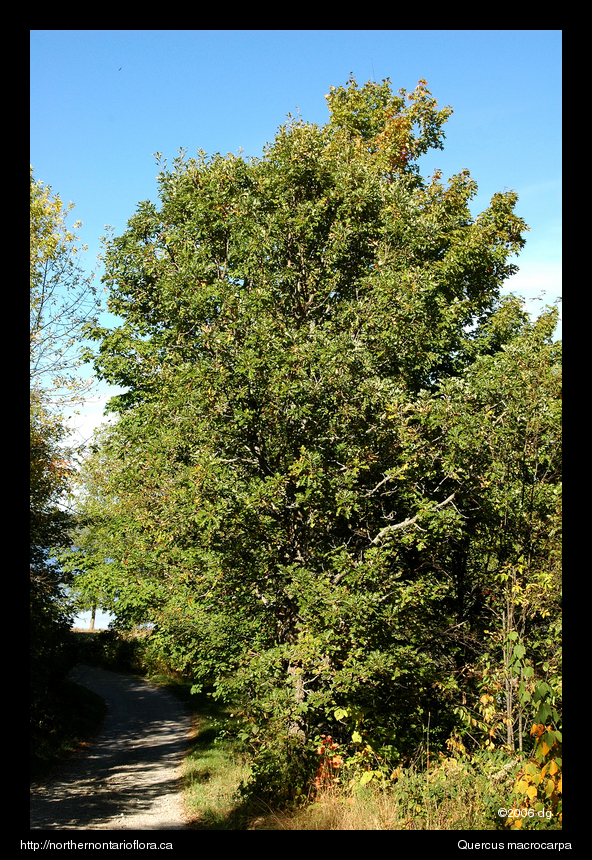
|
Northern Ontario Plant Database 
Plant DescriptionQuercus macrocarpa Michx.En: bur oak, mossycup oak, blue oak, scrub oak
Fagaceae (Beech Family) General: A medium-size, deciduous tree, to 20 m tall, with grayish to brown, flaky or scaly bark. Twigs somewhat stout, hairy when young, soon becoming smooth (glabrate); often bearing corky ridges. Twigs with a terminal cluster of short, blunt buds, yellowish-brown to gray; buds finely hairy, 3–6 mm long. Bud scales overlapping (imbricate), arranged in 5 vertical rows (5-ranked), leaf scars low-triangular, with rounded edges and several bundle trace scars. A transverse cut through the twig reveals the 5-angled pith, characteristic of all oaks. Leaves: Alternate, simple, pinnately-lobed, petioled. The blade 10–30 cm long, roughly obovate in outline, with 4–7 pairs of rounded lobes, interrupted towards the middle of the leaf by a deep sinus, often cut nearly to the midrib (a distinct shape named lyrate), the remaining lobes are separated by narrow, shallower sinuses. The blade is hairy when young, but becoming smooth (glabrate) and lustrous above, pale to white and finely hairy beneath, the hairs branches (stellate); the base is tapering (cuneate) to slightly heart-shaped (cordate). Flowers: Unisexual, with male and female flowers on the same tree (plants monoecious). Male flowers small, yellow-green, borne in narrow, elongate spikes, 5–10 cm long, each male flower with 6 stamens. Female flowers on short stalks (peduncles), borne in clusters of 1–5 reddish flowers; the base of each flower surrounded by a cupule, which develops into the cup or cap of the acorn. Each female flower has a single pistil with an inferior ovary. Fruit: A large acorn, with an ovoid nut surrounded at the base by a thick, scaly cup (cupule), 2–5 cm across, bearing overlapping scales; the cupule encloses the nut for one-third to more than half of its length. The upper scales of the cupule are prolonged into points, producing a fringed margin along the edge of the cup. Habitat and Range: Dry uplands to rich bottomlands, prairie grasslands, often associated with basic (calcareous) soils; drought and fire resistant, therefore well adapted to survival on sites with well-drained or shallow soils, such as dry sandy plains and limestone alvars. The bur oak is native to temperate eastern North America; it occurs in eastern and southern Ontario, along the southern portion of northwestern Ontario, and infrequently in the southern Algoma District. Internet Images: The Quercus macrocarpa webpage from the Trees of Wisconsin website. Click on the smaller images to view larger, more detailed photos. The Quercus macrocarpa webpage from the Virginia Tech Dendrology website. The Quercus macrocarpa webpage from the USDA Silvics of North America website. The leaves and acorns, and twigs of Quercus macrocarpa, from the Univ. of Wisconsin's Dendrology website. An illustration of Quercus macrocarpa, and other round-lobed oaks, from the Flora of North America series. Similar Species: The bur oak is most similar to Quercus alba (white oak), but the latter species is restricted to eastern and southern Ontario, found in the north only as a planted species. White oak leaves are smooth (glabrous), with several rounded lobes, but lack the interruption found in bur oak leaves. The oak most common in the deciduous forests of northern Ontario (mainly east of Superior) is Quercus rubra (northern red oak), easily distinguished by its bristle-tipped leaf lobes. On dry, sandy site in northwestern Ontario, the northern red oak is largely replaced by Quercus ellipsoidalis (northern pin oak). See the Quercus alba (white oak) and Quercus rubra (red oak) webpages from borealforest.org. Back to species list |
||||||||||||||||||||||










